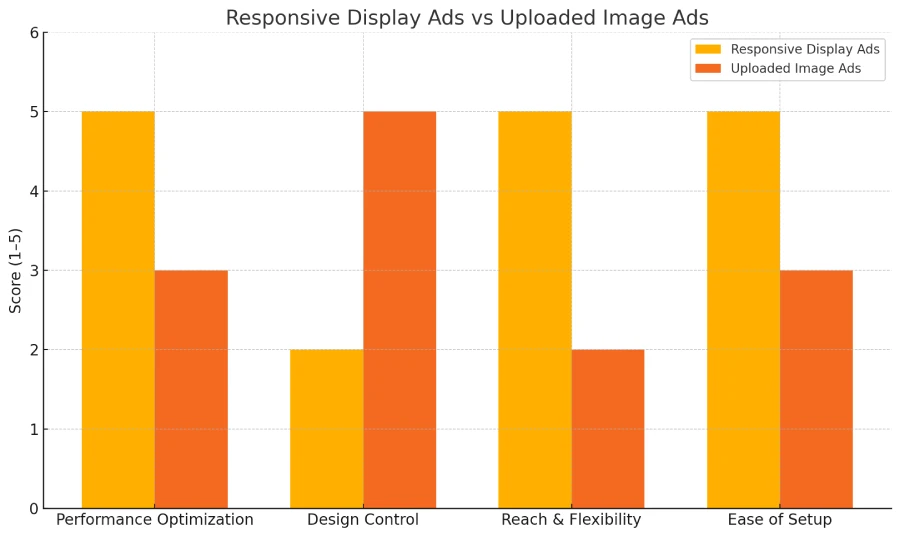I recently passed the Google Ads Display Certification exam and scored over 97%. One of the questions really stuck with me, not because it was tough, but because it helped me finally understand when to use responsive display ads in real campaigns.
In this post, I’ll explain the question, show the right answer and why it’s correct, go over why the other answers are wrong, and explain how Display Ads use automation to help you perform better. I’ll also share a real-life example, a visual comparison chart, and some helpful FAQs to make everything simple and clear. Let’s get started! 💡
Question
When should you use responsive display ads?
- When your primary goal is meeting branding requirements..
- When your primary goal is to control the look and feel of your ads
- When your ads will only be run in banner-eligible slots.
- When your primary goal is performance
Correct Answer
✅ When your primary goal is performance
Why This Answer Is Correct:
Responsive Display Ads (RDAs) are built for performance. Google automatically tests combinations of headlines, descriptions, images, and logos across the Display Network. It finds what works best and serves the best-performing combinations to the right users at the right time.
These ads are designed to:
- Adapt to any ad size or placement
- Maximize reach across websites, apps, and devices
- Automatically optimize for clicks, conversions, or other goals
In short: If your goal is results over design, RDAs are the smart choice.
Benefits of Responsive Display Ads:
- ✅ Automatically adjust size and format for any screen
- ✅ Use machine learning to improve performance over time
- ✅ Save time on design and manual testing
- ✅ Reach more placements than standard image ads
Data Insight:
Advertisers using RDAs see up to 2x more conversions compared to static image ads (Source: Google Internal Data).
❌ Why the Other Options Are Wrong
🚫 1. When your primary goal is meeting branding requirements
- If you’re a luxury brand or tightly controlled company (like Apple or Nike), branding matters more than reach.
- In this case, you’d use uploaded image ads where you can control every pixel, font, and color.
RDAs are not ideal when brand guidelines must be strictly followed.
🚫 2. When your primary goal is to control the look and feel of your ads
- Responsive ads sacrifice creative control for flexibility and scale.
- You can’t guarantee layout, font size, or how assets will appear.
- If design precision is your top priority — RDAs aren’t your go-to.
They optimize for performance, not design fidelity.
🚫 3. When your ads will only be run in banner-eligible slots
- RDAs are built to adapt to all ad placements, not just banner slots.
- Limiting them to banner-only spaces defeats the purpose — you’d be better off using custom banner uploads.
This option misses the power of RDAs: versatility + optimization.

Visual Comparison Chart:
| Use Case / Goal | Best Ad Type | Are RDAs Ideal? | Why / Why Not? |
|---|---|---|---|
| Drive performance and conversions | Responsive Display Ads | ✅ Yes | Auto-optimizes for best asset combination |
| Strict visual branding and layout control | Uploaded Image Ads | ❌ No | RDAs don’t allow fixed layouts or exact design styles |
| Limited to banner placements | Custom Banner Ads | ❌ No | RDAs work across many more placements |
| Quick setup and wide reach | Responsive Display Ads | ✅ Yes | Built for easy deployment and scaling |
Real-Life Example:
Let’s say you’re running an online store selling phone accessories. You upload a few headlines like:
- “Stylish Phone Cases for Any Model”
- “Shop Durable and Affordable Accessories”
Along with 5 product photos, 2 logos, and short descriptions. Google creates dozens of combinations, automatically testing them on YouTube, Gmail, and blog websites.
After a few days, Google identifies which text + image combo converts the best. You didn’t have to A/B test anything manually — Google’s AI did it for you.
That’s the power of performance-focused advertising with RDAs.
Resource Links
- Google Ads Help – Responsive Display Ads
- Google Smarter Ads with Machine Learning
- Skillshop – Google Display Ads Certification
FAQs:
Q1: Can I use logos and product images in responsive ads?
Yes. You can upload logos, product photos, and videos. Google will adapt them to each ad space.
Q2: Can I control where each asset appears?
No. Google auto-generates combinations, and you won’t control the final layout.
Q3: Are RDAs mobile-friendly?
Absolutely. They adjust to any screen size and run smoothly across all devices.
Q4: Can I track which asset works best?
Yes. Google Ads gives performance ratings like “Low,” “Good,” or “Best” for each asset.
Q5: Should I run RDAs and image ads together?
Yes! It’s often best to run both. Use RDAs for performance and reach, and image ads for strict branding needs.
Conclusion:
Responsive Display Ads are your go-to option when performance is the priority. Whether you’re running lead gen, sales, or traffic campaigns, RDAs help you get the best results with less manual effort. They work smarter, reach wider, and adapt to more placements than traditional ads.
If you’re preparing for the certification or managing real campaigns, remember:
✅ Use Responsive Display Ads when performance matters more than perfect design.
Now, if you are ready, you can take the Google Skillshop test for the Google Ads Display Exam. Want more real exam questions with easy answers like this? Follow along — I’ll be breaking down more Google Ads Display Measurement Certification Free examples in the next posts!

